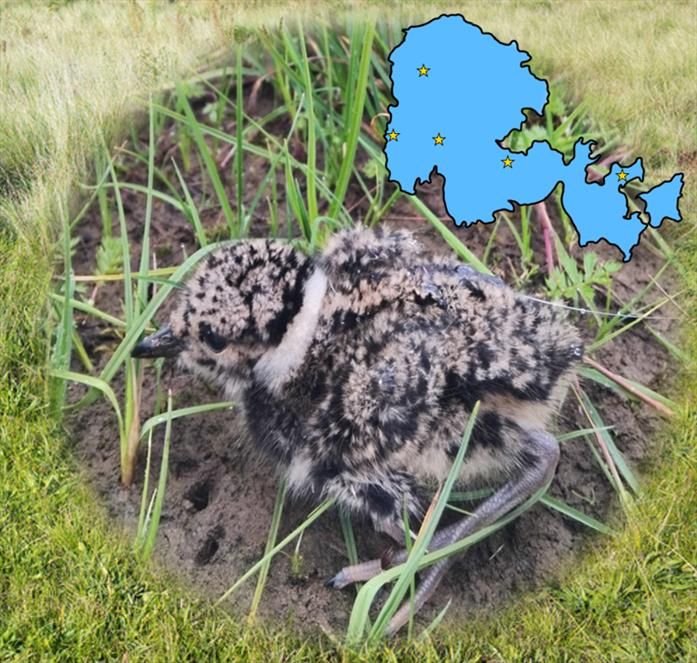6/6
🔬Next steps: DNA Barcoding and beyond
•Identifying predators from field signs was not always possible.
•We're piloting DNA metabarcoding to ID predators from chick remains.
•Analysis is ongoing—more insights to come as we uncover more about the early lives of wader chicks
02.04.2025 12:45 — 👍 5 🔁 0 💬 0 📌 0

Pictures showing the growth of 2 chicks. The chick raised in cattle grazed, wet field shows much higher growth and development than the chick raised in dry, sheep grazed field.
5/6
🌱 Growth & Habitat Effects
•Chick growth was highly variable across areas. Some chicks reached fledging condition weeks earlier than others.
•Chicks grew faster fields which were cattle-grazed, and wetter.
•Fields with standing water supported the highest growth.
02.04.2025 12:45 — 👍 7 🔁 2 💬 2 📌 1

A pie chart showing the cause of mortality of 23 recovered lapwing chicks. There is no one single dominant predator species. Rat = 2, stoat = 3, raven = 3, great black-backed gull = 1, short-eared owl = 3, avian unknown species = 10, not predated = 3
4/6
🐦⬛Who are the predators?
•Analysis of 23 predated chicks showed a range of predators, with no single dominant predator.
•This included: stoats, rodents, corvids, gulls & raptors.
02.04.2025 12:45 — 👍 2 🔁 0 💬 1 📌 0

Box plot showing the no of days survived of lapwing chicks across 5 different sites of varying habitat: marshland reserve, lochside reserve, low density mixed grazing, high density sheep, low density cattle grazing. There are no significant differences in survival between site, or reserve status.
3/6
📊 Survival Results
•Only 5 out of 71 chicks monitored survived to 30 days. This is exceptionally low compared to previous years.
•This was likely linked to prolonged cold, wet weather in 2024 leading to poor survival conditions.
•Predation was the dominant cause of mortality (47/49 chicks)
02.04.2025 12:45 — 👍 2 🔁 0 💬 1 📌 0

Schematic showing 3 species of wader and their estimated rate of decline over 3 generations (IUCN estimates). Eurasian oystercatcher = greater than 40%, Northern lapwing = 30-49%, Eurasian curlew = 30-49%
2/6
📌Background & Aims
•Breeding waders are in critical decline across Europe, linked to agricultural intensification & predation.
•Orkney is a stronghold for several wader species, but populations remain threatened.
•We radio tagged 49 Lapwing chicks to study survival rates.
02.04.2025 12:45 — 👍 2 🔁 0 💬 1 📌 0

Picture of a lapwing chick with a small radiotag attached to the back. Map of mainland Orkney above showing the location of study sites, which are in various areas across the island.
1/6
🔍Investigating drivers of wader chick survival on Orkney
Lapwing chicks face high mortality—our radiotracking study in 2024 explored survival rates, habitat effects & predation risks. What did we find? 🧵#BOU2025 #ornithology
02.04.2025 12:45 — 👍 32 🔁 16 💬 1 📌 1
she/they | SRUC Wildlife and Conservation Management Graduate | BTO Trainee Ringer
PhD Candidate @Newcastle exploring changes in biodiversity in ponds using eDNA. C permit BTO ringer and bird nerd 🐦🐦⬛🦉🦅 Gloucestershire 🏡
Birds & Art | PhD Student studying European Shag foraging behaviour | Previously Northern Isles Bird Obs AW & volunteer.
Wildlife conservationist. Vulture fan.
Profile pic by @ethankocak.com
Professor of Applied Ecology @ University of East Anglia. Bird migration, ecology, conservation, waders. Born @ 323ppm. http://wadertales.wordpress.com
The campaign to protect Curlews from extinction. Celebrating curlews on World Curlew Day (21 April)
Conservation Biology, Behavioural Ecology, Invasion Biology
The natural world, but if you insist on specifics: Islands, Birds, Mountains, Wildlife, Astronomy, increasingly dinosaurs again
PhD researcher - drivers of individual specialisation in foraging behaviour with #FalklandsShags 🐦 | seabirds | photography | crafting
PhD student interested in movement ecology, deserts, birds, tech. Runner, biker.
Protecting and restoring habitats, saving species and helping end the nature and climate emergency in Scotland.
BTO is the UK's leading Registered Charity working with volunteers to improve our knowledge of birds through monitoring and research. www.bto.org




